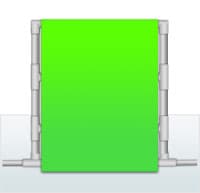


#CHEAP GREEN SCREEN LIGHTS TRIAL#
Wherever possible, set up your editing rig at the shoot, so that you can make trial composites in real time. To put the subject into the background instead of just in front of it, you need to match the background’s lighting. The next step is to make them equally effective as lighting designs. If you follow these guidelines, your composites will be technically successful, with clean edges and no dropouts.
#CHEAP GREEN SCREEN LIGHTS SOFTWARE#
If you can feed the camera signal into a computer right there at the shoot, which includes the keyed-in background, you can often move the backlight up or down until it and the software can live together happily. If you move in for closer shots, consider rolling up the part of the seamless backing that has been on the floor.Īnother caution: avoid excessive rim lighting, (I try to use little or none at all,) because the resulting hair sparkles can give the keying software fits. To solve the problem, mask the floor with a black drop cloth (or paper) placed in front of the subject, as near the feet as possible without showing in the frame. If the subject is standing on unrolled seamless paper backing, the floor itself can bounce colored light. If you are shooting close to white or light colored walls, move away if you can and mask them off if you can’t. Highly saturated backgrounds are very large sources of reflected light of exactly the green or blue color that you want to keep off your subjects (lest they start turning transparent). If you have the luxury of good separation, normal instrument heights are fine. If you must keep them close, elevated light positions will tend to splash on the floor rather than the backing. How high you set the lights depends on your subject-to-backing distance. To help do this, place both key and fill lights more to the sides than normal (around 5 and 8 o’clock on the standard lighting floor plan with the camera at 6 and the subject in the center). Spotlights work well with foreground subjects because their directional beams can be aimed away from (or masked off) the color backing. Again, if your software is up-to-date, you can shoot off the edges of the backing, as long as the subject is surrounded by the key color. To separate a subject from the backdrop, spot them as far out in front of the background as the space will allow. If you set white balance for 3200K, the background will look bluer but remember that the software can lock on any tint, so the slight color shift won’t matter. You can even mix them with halogen lighting for your subjects because their different color temperature won’t matter if you observe rule number two: light the subjects separately. Today, you can move your cursor over specific imperfections in the background displayed on your monitor and instruct the software to ignore them. Specifying a range of values reduces the overall quality of the composite.


This means you can get great results even with small screens and tight shooting areas.Įven the best-lit backdrops are not perfectly uniform, and the matte quality degrades where the background is slightly lighter or darker. All you have to do is ensure that your subject, at least, is surrounded by the key color. Now, most decent editing software packages will let you take an incomplete colored background and digitally stretch it to all four corners. Back in the medieval era (a couple years ago), the colored screen behind your subject had to fill the entire frame, so that the replacement background composited onto it would do the same. Maybe the biggest innovation is the elastic background. With today’s post production software, you can do truly cool stuff. So, when we talk lighting for compositing, we don’t just mean some jolly guy with a weather map. New compositing technology is making Hollywood movies virtually, well, virtual (check out the latest Star Wars flick, Episode III: Revenge of the Sith for a stunning example.) The same technology is available right on your desktop. Virtual green screen sets are no longer just for the privileged Hollywood bigwigs.


 0 kommentar(er)
0 kommentar(er)
